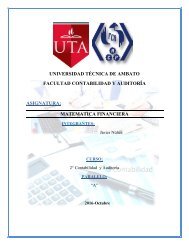Materia de Matematicas 2 A
Create successful ePaper yourself
Turn your PDF publications into a flip-book with our unique Google optimized e-Paper software.
z = 580∗12<br />
29<br />
6980<br />
29 = 240<br />
REPARTIMIENTO PROPORCIONAL DIRECTO<br />
Repartir 650 unida<strong>de</strong>s en parte directamente proporcionales:<br />
A: 8, 12,20, 29, 30, 31<br />
U=<br />
650∗8<br />
= 5200<br />
8+12+20+24+30+31 130<br />
U=40<br />
REPARTIMIENTO PROPORCIONAL CON FRACCIONES<br />
EJERCICIO:<br />
Repartir 650 unida<strong>de</strong>s en partes directamente proporcionales a:<br />
8, 12,20,29,30,31<br />
U = 650.8<br />
130 = 5200<br />
130 = 40<br />
V = 650.12<br />
130 = 13000<br />
130 = 60<br />
U = 650.29<br />
130 = 18850<br />
130 = 145<br />
U = 650.30<br />
130 = 19500<br />
130 = 150<br />
U = 650.31<br />
130 = 20150<br />
130 = 155<br />
650<br />
REPARTIMIENTO PROPORCIONAL INVERSO<br />
Para efectuar el repartimiento proporcional inverso <strong>de</strong> una <strong>de</strong>terminada cantidad se interviene<br />
los números dados y se reparte en partes directamente proporcionales a los inversos.<br />
EJEMPLO:<br />
Repartir 123 en partes inversamente proporcionales a=3.8.9<br />
X =<br />
Y =<br />
1<br />
3 , 1 8 , 1 9<br />
N ∗ a 123 ∗ 24<br />
=<br />
a + b + c 24 + 9 + 8 = 123.24 = 72<br />
41<br />
N ∗ a<br />
a + b + c = 123 ∗ 9<br />
24 + 9 + 8 = 123.9<br />
41 = 27






